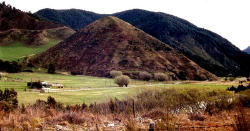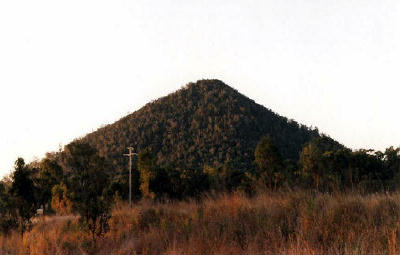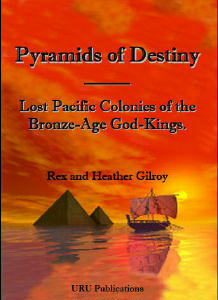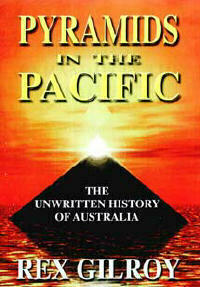
| Pyramids of Destiny – Lost Pacific Colonies of the Bronze-Age God-Kings |
 |
This pyramid-hill in the Rockhampton district, Queensland rises 90 metres high with its four sides facing the four points of the compass.
Egypto-Phoenician rock inscriptions have been found in the vicinity of this structure by the Gilroys. Photo copyright © Rex Gilroy 2008.
|
Pyramids of Destiny – Lost Pacific Colonies of the Bronze-Age God-Kings
by Rex & Heather Gilroy
Copyright
© Rex Gilroy 2009
| “Australian history is almost always picturesque; indeed it is so curious and strange, that it is itself the chiefest novelty the country has to offer, and so it pushes all other novelties into second and third place. It does not read like history but like the most beautiful lies. Mark Twain: Following the Equator [1891] |
”Every truth passes through three stages before it is recognised. In the first, it is ridiculed. In the second, it is opposed. In the third, it is regarded as self evident.” Arthur Schopenhauer [1788-1860] |
Part One.
The Rise of Civilisation Out of Australia – The Children of the Uru.
Chapter Four.
Pyramid Genesis.
For those readers interested in a complete history of the Uru and their megalithic culture, the authors recommend their book “URU – The Lost Civilisation of Australia”, [URU Publications 2005].Pyramids have always had a mystical hold on the mind of man. Why is this so? What is it about the pyramid shape that captures our imagination? They are to be found from the desert sands of Egypt to the jungles of New Guinea and Australia, certain west Pacific Islands and Central America.
It puzzles me why worldwide attention seems permanently focused upon the geometric dimensions of the Great Pyramid of Giza and those of the old Amerindian civilisations, while those of the Australian-west Pacific region continue to attract little or no attention from conservative archaeology, both here and overseas. Is it because they are an embarrassing enigma, demonstrating that the earth was explored and mapped thousands of years before the age of Magellan or Cook?
Yet the origins of the pyramid form and its purpose continue to escape the greatest minds. All eyes look to Egypt’s pyramids for the answers to these puzzles, without realising that the evolution of this most mystical of all human monuments began elsewhere, in the dawn mists of the Uruan Dreamtime on the most ancient of continents.
Conservative archaeology will give absolutely no consideration what-so-ever to the argument about to be presented in this chapter, for its adherents are adamant in their refusal to step beyond the limitations of the text book, which confines the origin of the true pyramid form firmly in ancient Egypt.
According to the conservative hypothesis, the origins of the pyramid began long before the age of the Pharaohs, when Stone-Age societies established themselves along the banks of the River Nile, for whose abundance of fish, fowl and other wildlife they relied upon for their sustenance.
Then around 5200 BC, these people abandoned their primitive hunter-gatherer existence, in the wake of the arrival of bands of settlers from the Fertile Crescent. Principally Sumerians, they brought with them the wheeled cart, livestock, domestic strains of wheat and barley, and the Sumerian system of writing. They influenced irrigation techniques, which led to the diverting of the Nile’s floodwaters into canals and catchments, which aided agriculture, the development of communities and the beginning of trade between them.
From the beginning, the fertile countryside along the Nile was divided naturally into two regions; Upper Egypt, comprising the narrow river valley extending northwards from around Aswan; and Lower Egypt, being the marshy country of the Nile Delta.
Then, in the year 3200 BC there arose a God-King, Menes, founder of the 1st dynasty, who united Upper and Lower Egypt into a single kingdom. Soon Egyptian merchants were pursuing foreign trade, and despite shifts in linage occasioned by the absence of heirs, and wars, the nation would rise to become the greatest civilisation of the Old World after Sumer. Thirty dynasties would come and go before Egypt fell to Alexander the Great in 332 BC, ushering in the rule of the Ptolemies [332-30 BC], which was followed in turn by the Roman occupation of 30 BC – 395 AD; and the Byzantine rule from 395-638 AD, by which time the glory of the Pharaohs was but a dim memory…
In the hope their remains would last through eternity, the 1st dynasty pharaohs had large mud brick tombs built for them in the Upper Egyptian town of Abydos, which would become the centre of the Osiris [nature god] cult.
These tombs were called mastabas and contained rooms in which were stacked tomb offerings of food, furniture, tools and weapons for the Pharaoh’s use in the next life…
The tombs of the Pharaohs underwent a radical change in the 3rd dynasty, about 2650 BC when King Djoser, founder of the dynasty, commissioned the building of a tomb that would reach to the sky.
This form of pyramid would be followed by the more familiar straight-sided examples of later Pharaohs. Mummification of the dead began around the beginning of the 4th dynasty about 2600 BC. The embalmers would first remove the dead Pharaoh’s internal organs by an incision in the abdomen,
these being placed in a Canopic jar, a vessel filled with natron. They then dried the body cavity and packed it with resin-soaked linen before preparing the exterior, which might include applying the face with green paint and placing jewellery and elegant robes on the shrouded corpse. The spread of the Djoser style step pyramid beyond the Nile can be seen in similar stone structures in south-east Asia, Australia and certain West Pacific Islands, always in the vicinity of precious metal deposits and nearby remains of ancient colonisation; which suggests that, Egyptian mining fleets were present hereabouts not long after the development of the Djoser step pyramid.
The presence of ancient mineral-seeking colonists in Australia is to be the principal theme of this book, yet the Pyramid had a vital role to play in the coming saga, for as the evidence to be presented will show, the Pyramid, in its original form, symbolised the mysterious great southern continent, the lost paradise of Mankind from where the first civilisation arose in the form of Uru, the race-memory of which would lead mineral-seeking colonists from the later offshoot civilisations of the Old, and also the New Worlds as the age of metals dawned, to sail in search of their “land of origin” and its fabled endless supply of all manner of wealth.
The pyramids that would soon arise amid the colonies established here by the Bronze-Age miners were, as we have already seen, by no means new, but their erection here had brought the pyramid form ‘full circle’, home to its land of origin. Thus the pyramids that stand today, crumbling and hidden away in dense tropical Queensland jungles and other hidden or desolate, remote regions of Australia, stand as a mute testament of the unknown history of the world and the creation of the earliest human civilisation on this planet. These “pyramids of destiny”, personified as a single form, is not only the symbol of the first civilisation which arose on the land of origin of all mankind, it is the symbol of the race itself that created it, the first Aryans.
Famed Norwegian explorer and anthropologist, the late Thor Heydahl once observed some similarities between the languages of the Polynesians and ancient Sumerians. For example, he observed that the name ‘Ur’ to the ancient Sumerians, as did the word ‘Uru’, meant “people of Ur”, which in turn was similar to ‘Urukehu’ in Polynesian language, which means “descendants of the first chiefs”. As we will see later, the Sumerians were well aware of Australia’s existence, calling it the Great South Land of Uru, and also ‘Uluru’, the same name by which Central Australian Aborigines know Ayers Rock and which means “People of Uru”, and also “Land of Uru”, and Auralia”, variously meaning “Land of the Aryans” and the “Great South Land of Gold”.
To the Sumerians it was the “Lost Paradise”, their land of origin, from where their Aryan ancestors had been driven out by natural disasters in the dim past.
Tradition says their ancestors migrated from the southern land of Uru to establish the Sumerian civilisation and the concept of the ziggurat, which symbolised the “Mountain of Paradise” that rose from the very centre of the “lost paradise”. Here the first man [Adama], and woman [Mammu] and serpent arose. However, they were driven out of ‘Paradise’ for displeasing the gods, journeying to Sumeria where they established the city of Ur. In reality, the man was symbolic of the Sky-Father, the woman the Earth-Mother and the Serpent, their child, the Sun-God, represented as a serpent in all ancient cultures.
This “Adam and Eve and the Serpent” mythology dates back into Stone-Age times, and had its origins in Australia with the Uruans, from whom the Australian Aborigines obtained the tradition. They believed the first man, woman and a serpent came up from the southern regions of the continent to create all mankind, and were eventually forced to journey northwards out of Australia because the land became inhospitable for most inhabitants. Such conditions, as we have seen, occurred in the closing stages of the last Ice-Age.
Further variations of the “Man, Woman and Serpent” myth were known to the Hittites over 3,000 years ago. Their traditions speak of the megalithic, astronomically aligned stone arrangements, that still dot their lands today, as the work of the “Sons of Uru”, who arose in the “lost paradise of all mankind”, which they believed was located in the southernmost region of the world, at the centre of which stood the great “World Mountain” guarded by serpents, the latter being symbolic of serpent [ie Sun] worshippers – the Uru.
On across Western Asia into the Slavic lands and into Western Europe we continue to find the name ‘Uru’ synonymous with the megaliths. The name ‘Uru’ only dies as the monuments decrease in the British Isles.
Thus, in Ireland ‘Uru’ refers to the ghostly “Son of Uru” while across Britain the megalithic people were called the ‘Muru’ or “speakers of the language of Uru”.
The name ‘Uru’ was spread by the Aryan Phoenicians throughout the Middle-East in a variety of forms. Thus ‘Muru’ or ‘Mer’ or ‘Marta’ became known as names of clans. These were the “Amorite Giants” of the Old Testament.
Throughout Ireland a prominent variation of ‘Uru’ is ‘Aru’ and ‘Aryan’, meaning ‘High’. In Cornwall it is ‘Arhu’ meaning “to command” and in Scotland ‘Aire’, meaning ‘Chief’ or ‘Prince’ or “exalted one” – the literal meaning for ‘Aryan’ in Indo-Persian languages. Then on to the island of Aran where ‘Arran’ means “Land of the Arya, or Aryans”, while in Wales ‘Annwyn’ was the name given for the southern hemisphere. The name of Iran itself, formerly Persia, is an ancient Persian word meaning “Land of the Aryans”.
Main Book Index | Mysterious Australia Homepage | URU Homepage | Australian Yowie Research Centre

